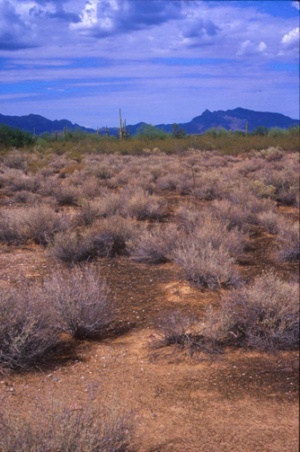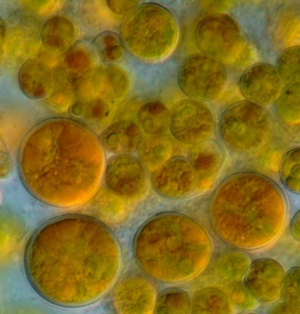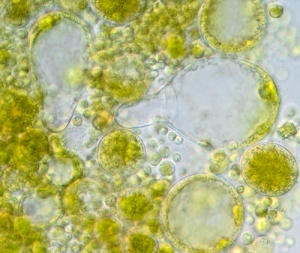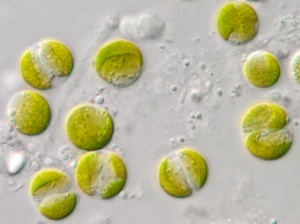Louise A. Lewis
| Associate Professor Department of Ecology and Evolutionary Biology office: 200 Pharmacy/Biology Building |
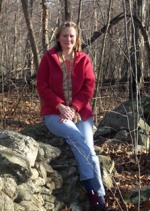
|
Research Interests
Desiccation Tolerant Algae: Diversity and Physiology
Many diverse green algae live in terrestrial habitats such desert microbiotic crust communities. My work in North American and South African arid habitats reveals that desert green algae have multiple evolutionary origins. I use traditional and molecular techniques to understand the diversity of desert green algae, and am interested in the physiological adaptations that allow these algae to survive under extreme conditions (e.g., desiccation, high light).
- Biotic Crust Project - A web site and relational database designed initially to disseminate results of an NSF-funded (Biotic Systems and Inventories) project to document the diversity of green algae, cyanobacteria, lichens and bryophytes of the desert crust communities of the western United States. Now, additional projects are being served at this site.
- Kaplan, F., L.A. Lewis, J. Wastian, and A. Holzinger (2011) Plasmolysis effects and osmotic potential of two Klebsormidium strains from alpine habitats. Protoplasma. DOI: 10.1007/s00709-011-0324-z
- Hall, J.D., K. Fučíková, C. Lo, L.A. Lewis and K.G. Karol (2010) An assessment of proposed DNA barcodes in freshwater green algae. Cryptogamie, Algologie 31: 529-555.
- Cardon, Z.G., D.W. Gray and L.A. Lewis (2008) The green algal underground – evolutionary secrets of desert cells. BioScience 58: 114-122.
- Gray, D. W., Z. G. Cardon and L. A. Lewis (2007) Photosynthetic recovery following desiccation of desert green algae (Chlorophyta) and their aquatic relatives. Plant Cell and Environment 30: 1240-1255.
- Lewis, L. A. and P. O. Lewis (2005) Unearthing the molecular phylodiversity of desert soil green algae (Chlorophyta). Systematic Biology 54: 936-947. Helpful link to computing phylodiversity measures discussed in this paper.
- Lewis, L. A., and V. R. Flechtner (2004) Cryptic species of Scenedesmus (Chlorophyta) from desert soil communities of western North America. Journal of Phycology 40: 1127-1137.
Evolution of green algae and early diverging lineages of green plants
I also am interested in morphological evolution within chlorophyceaen green algae, and have used molecular and morphological data to resolve the relationship among major groups of green algae and early-diverging land plants.
- Fučíková, K. and L.A. Lewis (2012) Intersection of Chlorella, Muriella, and Bracteacoccus: Resurrecting the genus Chromochloris Kol & Chodat (Chlorophyceae, Chlorophyta). Fottea 12: 83-93.
- McManus, H.A., P. Haugen, K. Fučíková and L.A. Lewis (2012) Invasion of protein coding genes by green algal ribosomal group I introns. Molecular Phylogenetics and Evolution 62: 109-116. DOI: 10.1016/j.ympev.2011.09.027
- Lewis, L.A., J.D. Hall, and F.W. Zechman (2011) Green Algae. In: eLS. John Wiley & Sons, Ltd: Chichester. DOI: 10.1002/9780470015902.a0000333.pub2
- McManus, H.A. and L.A. Lewis (2011) Molecular phylogenetic relationships in the freshwater family Hydrodictyaceae (Sphaeropleales, Chlorophyceae), with an emphasis on Pediastrum duplex. Journal of Phycology 47: 152-163.
- McManus, H.A., E. Schultz and L.A. Lewis (2011) Distinguishing multiple lineages of Pediastrum duplex Meyen 1829 with morphometrics, and a proposal for Lacunastrum N. Gen. Journal of Phycology 47: 123-130.
- Lewis, L. A. (2007) Chlorophyta on land. Independent lineages of green eukaryotes from arid lands. In: J. Seckbach (ed.) Extremophilic Algae, Cyanobacteria and non-photosynthetic Protists: From Prokaryotes to Astrobiology. Kluwer Academic Publishers, Dordrecht.
- McManus, H. A. and L. A. Lewis (2005) Systematics, morphological variation and implications for colony-form evolution in the family Hydrodictyaceae (Sphaeropleales, Chlorophyta). Phycologia 44: 582-595.
- Lewis, L. A. and R. M. McCourt (2004) Green algae and the origin of land plants. American Journal of Botany 91: 1535-1556.
- Shoup, S. and L. A. Lewis (2003) Polyphyletic origin of parallel basal bodies in swimming cells of chlorophycean green algae (Chlorophyta). Journal of Phycology 39: 789-796.
Symbiotic green algae
Unicellular green algae form symbioses with marine invertebrates, ciliates, fungi, and even flowering plants. In collaboration with Gisele Muller-Parker (Western Washington State University) I have worked on the small green alga that occur with the sea anemones Anthopleura elegantissima. Ph.D. student Molly Letsch is following up on this project in two anemone species, and across their geographic ranges.
- Letsch, M.R., G. Muller-Parker, T. Friedl, and L.A. Lewis (2009) Elliptochloris marina n.sp. (Trebouxiophyceae, Chlorophyta), green symbiont of Anthopleura xanthogrammica and A. elegantissima (Anthozoa, Cnidaria). Journal of Phycology 45: 1127-1135.
- Lewis, L. A. and G. Muller-Parker (2004) Phylogenetic placement of "Zoochlorellae" (Chlorophyta), algal symbiont of the temperate anemone Anthopleura elegantissima. Biological Bulletin 207: 87-92.
Beyond greens
- Haugen, P., D. Bhattacharya, J.D. Palmer, S. Turner, L.A. Lewis, and K.M. Pryer (2007) Cyanobacterial ribosomal RNA genes with multiple, endonuclease-encoding group I introns. BMC Evolutionary Biology 7: 159.
- Hershkovitz, M. A. and L. A. Lewis (1996) Deep-level diagnostic value of the rDNA-ITS region. Molecular Biology and Evolution 13: 1276- 1295.
- Hanelt, B., D. van Schyndel, C.M. Adema, L. A. Lewis, and E.S. Loker (1996) The phylogenetic position of Rhopalura opiocomae (Orthonectida) based on 18S ribosomal RNA sequence data. Molecular Biology and Evolution 13: 1187-1191.
- Wawrzyniak, L.A. and R.A. Andersen (1983) Silica-scaled Chrysophyceae from North American boreal forest regions in northern Michigan, U.S.A. and Newfoundland, Canada. Nova Hedwigia 41: 127-145.
 |
 |

|
Courses
Spring 2011 (usually in spring semesters of odd years, 2011, 2013, ...)
- I teach introductory biology for majors, Biology 1108. This course web site is accessed using HuskyCT.
Spring 2012
- During alternate spring semesters (next in 2012) I co-teach Evolution of Green Plants with Dr. Bernard Goffinet.
Fall 2012 (fall semesters of even years)
- I will teach Biology of the Algae (co-listed as EEB 3250 and EEB 5250).
